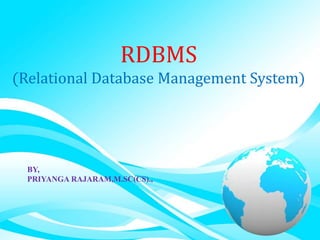
rdbms-161216100344 (1).pdf
- 1. RDBMS (Relational Database Management System) BY, PRIYANGA RAJARAM,M.SC(CS).,
- 2. Overview What is DBMS RDBMS Relational Algebra Structured Query Language Difference between DBMS and RDBMS Advantage of RDBMS
- 3. What is DBMS? DBMS (Database Management System) is a system that is used to store and manage data. A DBMS is a set of programs that is used to store and manipulation data. Manipulation of data includes the following: Adding new data Deleting unwanted data Changing existing data For example adding details of new student, deleting the details of student who have completed course and modifying the fee paid by the student.
- 4. It provides various functions like: Data security Data integrity Data sharing Data concurrence Data independence Data recovery
- 5. RDBMS(Relational Database Management System) RDBMS stands for Relational Database Management System. RDBMS data is structured in database tables, fields and records. Each RDBMS table consists of database table rows. Each database table row consists of one or more database table fields. RDBMS store the data into collection of tables, which might be related by common fields (database table columns). RDBMS also provide relational operators to manipulate the data stored into the database tables.
- 6. Most RDBMS use SQL as database query language. The relation is the only data structure used in the relational data model to represent both entities and relationships between them. Rows of the relation are referred to as tuples of the relation and columns are its attributes. Each attribute of the column are drawn from the set of values known as domain. The domain of an attribute contains the set of values that the attribute may assume.
- 8. Tuple / Row A single row in the table is called as tuple. Each row represents the data of a single entity. Attribute / Column A column stores an attribute of the entity. For example, if details of students are stored then student name is an attribute; course is another attribute and so on. Column Name Each column in the table is given a name. This name is used to refer to value in the column.
- 9. Table Name Each table is given a name. This is used to refer to the table. The name depicts the content of the table. The following are two other terms, primary key and foreign key, that are very important in relational model. Relational Algebra A set of operators used to perform operations on tables is called as relational algebra. Operators in relational algebra take one or more tables as parameters and produce one table as the result. The following are operators in relational algebra: Union Intersect Difference or minus Project Select Join
- 10. Union This takes two tables and returns all rows that are belonging to either first or second table (or both). Intersect This takes two tables and returns all rows that are belonging to first and second table. Difference or Minus This takes two tables and returns all rows that exist in the first table and not in the second table.
- 11. Project Takes a single table and returns the vertical subset of the table. Select Takes a single table and returns a horizontal subset of the table. That means it returns only those rows that satisfy the condition. Join Rows of two table are combined based on the given column(s) values. The tables being joined must have a common column.
- 12. SQL(Structured Query Language) Almost all relational database management systems use SQL(Structured Query Language) for data manipulation and retrieval. SQL is the standard language for relational database systems. SQL is a non-procedural language, where you need to concentrate on what you want, not on how you get it. Put it in other way, you need not be concerned with procedural details.
- 13. SQL Commands are divided into four categories, depending upon what they do. DDL (Data Definition Language) commands are used to define the data. For example, CREATE TABLE. DML (Data Manipulation Language) commands such as, INSERT and DELETE are used to manipulate data. DCL (Data Control Language) commands are used to control access to data. For example, GRANT. Query (Retrieving data) It is used to retrieve data using SELECT. DML and Query are also collectively called as DML. And DDL and DCL are called as DDL.
- 14. Difference between DBMS and RDBMS DBMS A DBMS is a storage area that persist the data in files. To perform the database operations, the file should be in use. Relationship can be established between 2 files. There are limitations to store records in a single database file depending upon the database manager used. DBMS allows the relations to be established between 2 files. Data is stored in flat files with metadata. DBMS does not support client / server architecture. DBMS does not follow normalization. Only single user can access the data. DBMS does not impose integrity constraints.
- 15. RDBMS RDBMS stores the data in tabular form. It has additional condition for supporting tabular structure or data that enforces relationships among tables. RDBMS supports client/server architecture. RDBMS follows normalization. RDBMS allows simultaneous access of users to data tables. RDBMS imposes integrity constraints.
- 16. Advantages of RDBMS A "relational database" is a database structured on the "relational" model. Data are stored and presented in a tabular format, organized in rows and columns with one record per row. Data Structure Multi-User Access Privileges Network Access Speed Maintenance Language